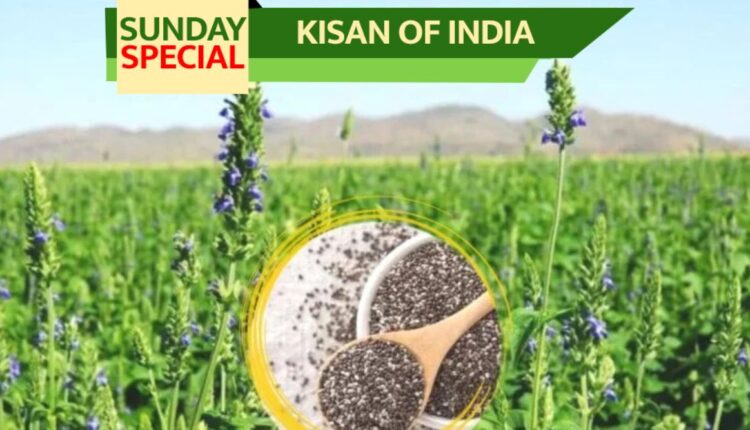Chia Farming: If you want to earn twice the cost then this
Chia crop is neither affected by disease-pests nor is there any possibility of spoilage.
Chia, or Mexican chia, is an oilseed crop. It is relatively new to Indian farmers, but its popularity is growing rapidly, as according to agricultural experts, the yield from chia cultivation can fetch more than double the cost in the market. That is, Chia is a great option for making better profits in farming. Rich in nutrients, chia is an extremely low-maintenance crop. Chia crop remains free from diseases and pests. There is no possible damage to its crop, so Chia farmers do not have to worry about loss in cultivation.
Chia is a major commercial crop in Mexico and Guatemala in South America. Spreading from the mountainous areas, its cultivation was also established in Australia, Bolivia, Colombia, Peru, and Argentina. In India, scientific cultivation is being done in Madhya Pradesh, Andhra Pradesh, Gujarat, Karnataka, Rajasthan, and Haryana. Chia oil’s growing popularity is due to its high levels of polyunsaturated fatty acids. For this reason, the trend of using it mixed with traditional edible oils is increasing rapidly. Chia belongs to the family of Tulsi (Lamiaceae), which is why the properties of Tulsi are also found in it.
Scientific Cultivation of Chia
Chia can be grown easily in moderately fertile and well-drained soil. Chia has the ability to tolerate acidic soil to a great extent. But its yield decreases in more saline and alkaline soils. Sandy loam soil is most suitable for a good yield of Chia. Progressive farmers in central and south Indian states also cultivate chia seeds for export. It is better to do organic farming of Chia for good nutritional production.
Chia Sowing Time
The research of the Agricultural Research Center of Mandore affiliated with Jodhpur Agricultural University has proved that the best time to sow Chia in the Indian climate is from the 5th to the 25th of October. At the time of sowing, the temperature of 25 to 30 degrees Celsius is most suitable for good germination of chia seeds. Although Chia is very sensitive to cold, it likes the coolness of December and January. This season, flowers come in chia, and filling grains in earrings starts.
Preparation and Sowing for Chia Cultivation
A deep plowing is sufficient to prepare the field before sowing chia. After this, harrowing should be done and paving should be done. Good quality seeds should be used for sowing. If Chia seeds are not available with your nearest seed seller, then you should contact the nearest Krishi Vikas Kendra (KVK).
Sowing of Chia: Chia can be sown with seed drill or sowing machine. Since chia seeds are so small, some adjustments may need to be made to the seed drill equipment. Chia seed can be mixed with roasted millet at the rate of 3 to 7 ratio to ensure the desired seed rate for sowing. At the time of sowing, row to row distance of 30 to 45 cm and plant to plant distance of 30 cm should be kept.
Seed Quantity: On accurate sowing with a standard seed drill at a fixed distance, only 500 grams of seed is sufficient in one hectare. But usually 2 to 2.5 kg of seed is used for sowing Chia in one hectare. Spacing may need to be improved as chia plants grow in the field after germination. Two weeks after sowing the plants are thinned at a distance of 30 cm.
Use of Manure in Chia Cultivation
It is very beneficial to give 10-15 tonnes of well decomposed cow dung manure per hectare to get good nutrition and good yield of Chia crop. In light soils, giving 20-30 kg Nitrogen, 20-25 kg Phosphorous and 15-20 kg Potash per hectare at the time of sowing is beneficial for the required growth of plants. If required, 10 kg Nitrogen per hectare can also be given 30-45 days after sowing.
Chia Crop Irrigation
Chia must have sufficient soil moisture at the time of sowing for the seeds to germinate. The number of irrigations will depend on the type of soil and the ambient temperature. Generally, 4-5 irrigations are required after sowing in sandy or sandy loam soil. But when Chia crop is about to ripen, its sensitivity to moisture increases a lot, so do not irrigate during that period.
Chia plant can grow up to 1 meter tall. Its leaves are 1.5 to 3 inches long and 1 to 2 inches wide. Small flowers of 3-4 mm size of white or purple color bloom in it. They have the property of self pollination. Its oval and black, brown and black-white spots are in color and their diameter is 1 to 2 mm.
Weed and Pest Control
Chia itself is a powerful crop. It doesn’t care much about weeds. Nevertheless, the management of weeds in the early stages of plant development is of great benefit. Plowing with tractor drawn hoeing or hand hoe 25-30 days after sowing can control the weed. Chia plants are not a problem with pests and diseases. But many times when the crop is about to ripen, an outbreak of ants has been seen on its earrings. To prevent this, a line of insecticide powder can be made around the field.
Chia must be protected from Frost
The effect of frost has been observed on Chia crop. Chia is sensitive to the cold of December and January. This causes its tender leaves and emerging earrings to turn black. The filling of seeds in the crop and the yield are affected by the effect of frost. That’s why the soil temperature should be maintained comfortable by doing light surface irrigation of the field in frost prone season.
Harvesting, Threshing, Yielding and Storage
Chia crop ripens in 120-130 days. Then all its leaves fall off and only earrings remain on the stem. In developed countries it is harvested by machines like other small seed crops like berseem and rizka, but in India the crop is harvested with sickles or sickles. In threshing, seeds are separated by pressing/crushing the Chia ears with wooden sticks.
Chia threshing is also done with little addition to a standard thresher using a small screen. By cultivating Chia with the above general production method, a yield of 6 to 8 quintals per hectare can be obtained. Cleaned and dried seeds can be kept in normal barn or godown for 3-4 months.
Chia Nutrients and Uses
Chia seeds contain 15 to 25 percent protein, 30 to 33 percent fat, 26 to 41 percent carbohydrate, 18 to 30 percent high dietary fiber, and many minerals, vitamins, and antioxidants. Its oil is rich in polyunsaturated fatty acids such as omega-3 and omega-6. Chia oil contains up to 67 percent alpha linolenic fatty acid. This is the highest among all oils.
Chia is cultivated for the oil obtained from its seeds, as it is added to traditional edible oils to enhance its nutritional value. For weight loss, it should be consumed only with the advice of a doctor. Chia is also eaten sprouted or raw. In many countries such as the United States, Canada, Chile, Australia, New Zealand, and Mexico, chia is eaten with cookies, snacks, bars, cakes, yogurt, and fruit juices.
Contact us – If farmers want to share any valuable information or experiences related to farming, they can connect with us via phone or whatsapp at 9599273766 or you can write to us at “[email protected]”. Through Kisan of India, we will convey your message to the people, because we believe that if the farmers are advanced then the country is happy.
You can connect with Kisan of India on Facebook, Twitter, and Whatsapp and Subscribe to our YouTube channel.



